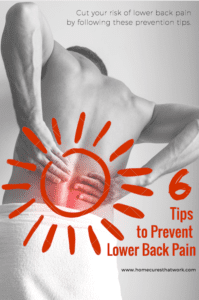6 Ways to Knock Out Back Pain Without A Pill
Lower Back Pain? Drugs vs. Real Pain Relief
When you have lower back pain, you don’t want to do anything but lay in bed. But the best thing you can do for a bad back is to stretch. The nice thing about stretching your back is that you can do it while in pain and experience almost immediate relief. By stretching, you can keep your body happy and pain free.
There are many conditions associated with lower back pain. Understanding back pain’s root cause is crucial to getting you on the road to recovery. Not sure of why you’re in agony? Here are some of the common causes for lower back injuries:[1]
- Improper lifting – Either lifting something too heavy, lifting with the back instead of the legs, or holding an object away from your body instead of “hugging” it.
- Overuse – Perhaps you’ve experienced lower back pain from working in the garden, scrubbing the floor, or other physical work that you’re unaccustomed to.
- Degenerative disc disease – This can occur with aging.
- Disc tear – Sometimes happens due to an injury.
- Fractures in the vertebra – This is often caused by osteoporosis.
- Spinal stenosis – This puts pressure on the spinal cord due to a narrowing of the spinal column.
- Scoliosis – This is abnormal curvature of the spine.
- Smoking – Smoking damages virtually every function in the body including the lower back.
There are many other causes of lower back pain and due to the general nature of the pain, doctors find that the cause is often difficult to diagnose.[2]
The Purpose of Pain
While no one likes to experience pain, without pain we wouldn’t live for very long. Pain alerts us that there’s something wrong. Pain either warns of possible injury if we continue what we’re doing, or it tells us we’ve already injured ourselves and we need to take measures to repair the injury. Without the warning system of pain, we would continue to injure ourselves to the death! This is precisely what happens with neuropathy—a deadening of the nerves to the feeling of pain.
6 Tips to Prevent Lower Back Pain
You can cut your risk of lower back pain by following these general prevention tips below.
- Practice good posture when sitting and standing.
- If you sit at a desk all day, request an ergonomic evaluation to ensure that your work area is arranged for optimal posture. Also, get up frequently to stretch your back and walk around. Consider working at a standing workstation.
- Follow proper lifting techniques whenever you lift anything. Don’t lift more than you are able. Ask for help. Lift with your legs and hold the object close to your body.
- Lose weight if you are overweight. A large belly and extra pounds place undue pressure on the spine and muscles.
- Exercise regularly and stay active. Keeping your core muscles fit helps support your lower back and can help prevent other common injuries. Walking is one of the best exercises for back health.
- Quit smoking if you smoke. Those who smoke are nearly a third more likely to develop lower back pain than those who don’t smoke.[3]
Pain Management vs. Pain Relief
Lower back pain can range anywhere from searing, excruciating pain to a dull ache. When we’re in pain, our first thought is to eliminate the pain. But there’s a difference between managing pain and relieving it.
Managing our back pain has more to do with coping with it and alleviating the symptoms. This is where most people reach for medication. By contrast, pain relief seeks to discover the cause of the pain and repair the injury so that pain management is no longer necessary. Our goal is relief from pain, not merely managing it.
There are inherent dangers in trying to manage lower back pain with drugs. The site drugs.com compares a whopping 113 drugs commonly prescribed for back pain. Yikes—113![4] The fundamental problem with reaching for a drug is that it only treats the symptoms, not the cause of the injury.
We may need some temporary reprieve from the pain through medication so we can determine the cause and take steps to heal. But too many people see drugs as the remedy for lower back pain. Drugs do not provide a remedy, but instead may lead to other even more serious issues.
One drug that doctors are prescribing often today for lower back pain is Lyrica. Lyrica is commonly used to treat nerve pain for people suffering with fibromyalgia. But a study conducted in Great Britain showed that Lyrica was no more effective in managing back pain than a placebo (sugar pill)![5]
The fact that Lyrica is ineffective is only the beginning of the problem. Lyrica and many other drugs like it are costly, produce serious side effects and are often addictive. Lyrica’s own official warnings state that it “May cause serious allergic reactions or suicidal thoughts or actions…swelling, trouble breathing, rash, hives, blisters, changes in eye sight including blurry vision, muscle pain with fever, tired feeling or skin sores. Common side effects are dizziness, sleepiness, weight gain and swelling of hands, legs and feet.”[6]
What their warnings don’t reveal is that Lyrica is addictive and withdrawal can be a hellish experience that may include many of its side effects.
A much healthier way to manage lower back pain includes:
- Maintaining proper posture when sitting or standing
- Getting up and walking around frequently
- Stretching your back often throughout the day
Find More Permanent Lower Back Pain Relief
Once again, many are prone to take the “easy road” to relief from back pain and opt for surgery. While surgery may be necessary for some, failed back surgeries occur at an “alarming rate.” Failed back surgeries often require additional surgeries to repair. People who opt for back surgery are less likely to return to work than those who don’t go under the knife. Also, pain reduction from back surgery is minimal. Those who choose surgery often require more pain medication after the surgery than before.[7]
How do we find more lasting relief from lower back pain? Through stretching and exercise. Weak muscles and lack of flexibility set us up for injury, strain and lower back pain. By contrast, exercise and stretching:
- Increase muscle strength
- Improve flexibility
- Help reduce weight
- Improve posture
- Increase blood-flow
- Move nutrients and fluids throughout the body to support good health
6 Simple Stretches to Relieve Lower Back Pain
Stretching is vital for flexibility and strength. Never bounce while stretching. Stretches should be gradual and deliberate. You should feel your muscles and ligaments stretching, but stretching should not be painful. The following 6 stretching exercises for the lower back pain are great even if you already suffer from back pain.[8] Use a mat or a carpeted floor.
- Knee to chest – Lie on your back on the floor and point your toes straight upward. Slowly bend your right knee, bringing it up to your chest. Grasp your right thigh, knee or shin with both hands clasped together and pull your knee towards your chest gently. Hold this position for 20 seconds then slowly lower your leg back to the starting position. Repeat this three times with each leg.
- Lying Knee Twist – Lie on your back with your legs straight out. Bend your right leg at the knee and bring it over the left side of your body. Find a position in which you feel a gentle stretch in your back and buttocks muscles and hold it for 20 seconds. Then rotate your leg back to the starting position. Repeat three times with each leg.
- Cat Stretch – You’ve probably seen a cat arch its back up to stretch. Begin by getting down on the floor on all fours with your hands directly below your shoulders and your knees below your hips. Exhale and gently arch your back downward and hold for 5-10 seconds. Then, inhale and arch your back upward like a cat. Hold this position for 5-10 seconds as well. Repeat 10 times.
- Piriformis Seated Stretch – Sciatica or radiating leg pain is often linked to the piriformis muscle. Sit on the floor with your back straight. Cross your left leg over your right leg, placing your left foot on the floor and tucking your right foot up to your buttocks. With your right hand, pull your left knee toward your body slowly. Keep your back straight and chest up. Hold this position for 20 seconds and repeat three times with both legs.
- Cobra Stretch – Lie flat on your stomach with your legs fully extended and the fronts of your feet flat on the floor. Slowly bend at the waist and push your torso upward resting on your forearms with your palms flat on the floor. Keep your head straight up and your hips on the ground. Find a comfortable position that gently stretches your lower back and abdominal muscles and hold for 10 seconds. Slowly return to the starting position and repeat five times. If you feel flexible enough, try pushing all the way up on your hands for an additional stretch.
- Restful Pose – Position yourself on your hands and knees on the floor. Spread your knees slightly wider than your hips. Turn your toes inward so both feet touch. Lower your buttocks as far back toward your feet as possible. When you find a comfortable position, extend your arms fully forward, resting them on the floor. This will bring your forehead to the floor. Relax and hold for 20 seconds and slowly return to the starting position and repeat three times. If you are unable to extend your arms above you due to shoulder pain, let your arms fall to either side of your body toward your feet.
Any time you feel lower back pain, let that signal you that it’s time to stretch. You can strengthen your lower back and remedy pain by doing these gentle exercises.
Also, remember to maintain good body posture always. When you catch yourself slouching, or leaning into your computer or desk, correct your posture. If you sit a lot at work, get up and stretch your back, and walk around frequently. Sitting puts 40% more pressure on your spine than standing does.[9] So the more time you can spend on your feet, the less back pain you’ll have to endure.
Finally, a regular, brisk walk in which you’re taking nice long strides works wonders for preventing and relieving lower back pain. Walking is great for your cardio health as well. Consider walking over your lunch break, or some other time that you can work it into your daily routine.
Remember, you want pain relief rather than merely managing your back pain. Lower back pain can be prevented. If you stick to these tips and stretches, you can say goodbye to lower back pain for good.
And if sciatica pain has you down, try these sciatica pain relief exercises to take your life to the next level. If time is tight, then try this shorter workout to yield more impressive results.




















